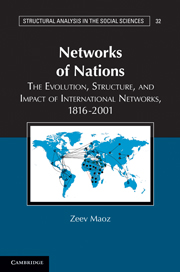Book contents
- Frontmatter
- Contents
- Preface
- Part I What Are International Networks?
- Part II The Formation of International Networks: Theory and Evidence
- Part III The Implications of the Networked International Politics Theory
- 8 Democratic Networks: Resolving the Democratic Peace Paradox
- 9 Interdependence and International Conflict: The Consequences of Strategic and Economic Networks
- 10 Evolution and Change in the World System: A Structural Analysis of Dependence, Growth, and Conflict in a Class Society
- 11 An International System of Networks: How Networks Interact
- 12 The Network Analysis of International Politics: Insights and Evidence
- Glossary
- Bibliography
- Author Index
- Subject Index
11 - An International System of Networks: How Networks Interact
Published online by Cambridge University Press: 05 June 2012
- Frontmatter
- Contents
- Preface
- Part I What Are International Networks?
- Part II The Formation of International Networks: Theory and Evidence
- Part III The Implications of the Networked International Politics Theory
- 8 Democratic Networks: Resolving the Democratic Peace Paradox
- 9 Interdependence and International Conflict: The Consequences of Strategic and Economic Networks
- 10 Evolution and Change in the World System: A Structural Analysis of Dependence, Growth, and Conflict in a Class Society
- 11 An International System of Networks: How Networks Interact
- 12 The Network Analysis of International Politics: Insights and Evidence
- Glossary
- Bibliography
- Author Index
- Subject Index
Summary
Introduction
Most international relations scholars envision an international system as a set of state (and/or nonstate) actors that interact with each other according to a set of rules. These rules are derived from a structure, often defined in terms of the number of major powers and the distribution of capabilities among them (Kaplan, 1957; Waltz, 1979: 53). World system theories define structure in terms of a division of labor among state and nonstate units. The dominant mode of production at a given historical period determines the relative advantages of units and assigns states into “classes” or functional groups (Wallerstein, 1974). As we saw in Chapter 10, these two conceptions converge to some extent in the real world, but we do not have good theories of why this overlap should be observed.
One of interesting paradoxes in the study of global systems is that there is a voluminous literature on system effects, yet little theorizing exists about the causes of systemic structure. Most system theories do not contain clear and empirically testable explanations of structural change (Maoz, 1996: 1–28). Both approaches to the global system spend a great deal of time characterizing different structures. Both approaches have multiple explanations of how structures affect behavior or processes at various levels (Jervis, 1999). Neither approach provides a compelling explanation of when, why, and under what conditions structures change. The few attempts to theorize about structural changes (e.g., Gilpin, 1981; Wallerstein, 1989; Wendt, 1999) are framed in vague terms or involve circular reasoning. For example, Gilpin claims that an international system changes when one or more key actors are dissatisfied with the existing structure and act to change it. But one could always argue that when systems have changed, it was because enough actors had wanted change. Likewise, constructivists view changes in international culture as a result of ideational change in actors. But ideational changes are due to experience gained via interactions that are due to behaviour that is consistent with ideational factors, which are due to interactions .… and so on.
- Type
- Chapter
- Information
- Networks of NationsThe Evolution, Structure, and Impact of International Networks, 1816–2001, pp. 333 - 364Publisher: Cambridge University PressPrint publication year: 2010

